The Parts download contains everything you need to get an Altium DBLib library up and running in less than 5 minutes.
You do NOT need to have Access installed to use a DBLIB library in Altium.
Using Altium's DBLib interface you can edit and add parts to an Access database.
Take the challenge and see for yourself that you can have your own fully functional DBLib library in 5 minutes or less.
Here are the steps to quickly setup and use the Parts DBLib library:
Download Parts DBLib.
Install the Parts DBLib Library in Altium. See Getting Started.
Use Altium's DBLib to edit or add parts to the database.
You are done, you should have a fully functional Altium DBLib library.
If you are looking for an efficient and easy way to edit and add parts to the database give the Parts Frontend a test drive.
The Parts DBlib download includes a demo version of the Parts Frontend. A Frontend application is not required to use an Altium DBLib or SVNDBLIB library.
When using a well designed database Frontend you will spend significantly less time designing library parts, leaving you with more time to design boards.
That's It !
Saturday, November 14, 2015
Tuesday, October 20, 2015
What Makes Parts Different ?
Parts can also be used to cleanup libraries before importing to Altium 365 Managed Components.
It takes less than 5 minutes to download and start placing parts from the Parts DBLib library. See Getting Started.
It takes less than 5 minutes to download and start placing parts from the Parts DBLib library. See Getting Started.
Link to Customer Comments on LinkedIn.
When you download Parts you get a fully functional Altium DBLIB database library for Free.
An optional (not required) Frontend application is available for users that are looking for a turn-key solution with user friendly interface.
The Parts Frontend application supports Git, DBLIB and SVNDBLIB libraries in Altium.
When you download Parts you get a fully functional Altium DBLIB database library for Free.
An optional (not required) Frontend application is available for users that are looking for a turn-key solution with user friendly interface.
The Parts Frontend application supports Git, DBLIB and SVNDBLIB libraries in Altium.
Using Parts you can quickly enter parametric data into your library.
The WorkFlow for creating components using Parts is very efficient.
Trim and Clean removes extra white spaces and formatting characters in the database.
Option to use Preferred Mfr and Supplier names.
Parts simplifies Backing up and Compacting the database.
Migrating from DBLIB to SVNDBLIB can be accomplished in less than one hour.
Easy Migration to MySQL with 100% compatibility to the Parts Access database.
Parts includes Export to Excel and Import from Excel with field (parameter) mapping.
Parts has Configuration options that support a variety of customer requested features.
Make Like and Drag and Drop makes creating similar components simple and fast.
To request technical support or a demo use the Contact Parts page.
No IT department support is required for getting started with Access. Users only need read and write permissions to a shared folder on a local or network drive. User permissions to the database can be controlled using folder permissions.
Parts Supports Multiple Users
See the Videos on YouTube
Request Support:
Contact Parts for technical support or a Free online demonstration.
That's It !
Friday, October 9, 2015
Parts - Hat Tricks
There are a couple of hat tricks that can be used to increase your productivity.
Digi-Key example:
Start a new record, enter a Mfr P/N i.e. 90120-0122, then select Digi-Key as the supplier.
Double click on the black hat.
You should see the Mfr P/N data displayed on the Digi-Key site.
Drag and drop the Digi-key URL into the black hat to fill in the parametric data.
Mouser Example:
The same trick can also be used for finding parts at Mouser.

What happens when you double click on the black hat depends on what data is in the record and which supplier is selected.
If you double click on the black hat and the Supplier Part Details URL is valid, your browser will go to the web page at the address shown in the Link 2 URL field.
If the URL link to the Supplier Part Details is not valid or is blank, then Parts will try to find the part using the Supplier Part Number.
If the Supplier Part Number is blank then Parts will try find the part using the Manufacturer Part Number.
That's It !
Digi-Key example:
Start a new record, enter a Mfr P/N i.e. 90120-0122, then select Digi-Key as the supplier.
Double click on the black hat.
You should see the Mfr P/N data displayed on the Digi-Key site.
Drag and drop the Digi-key URL into the black hat to fill in the parametric data.
Mouser Example:
The same trick can also be used for finding parts at Mouser.

What happens when you double click on the black hat depends on what data is in the record and which supplier is selected.
If you double click on the black hat and the Supplier Part Details URL is valid, your browser will go to the web page at the address shown in the Link 2 URL field.
If the URL link to the Supplier Part Details is not valid or is blank, then Parts will try to find the part using the Supplier Part Number.
If the Supplier Part Number is blank then Parts will try find the part using the Manufacturer Part Number.
That's It !
Thursday, October 8, 2015
Create a SVNDBLIB Repository
With TortoiseSVN installed, use your Windows file explorer to select a place on a shared network drive, then create a folder.
Name the repository folder to something that works for you.
Example: To create the repository "Parts_Repo" folder.
Using Windows file explorer select the "Parts_Repo" folder.
Then Right Click > TortoiseSVN > Create repository here.
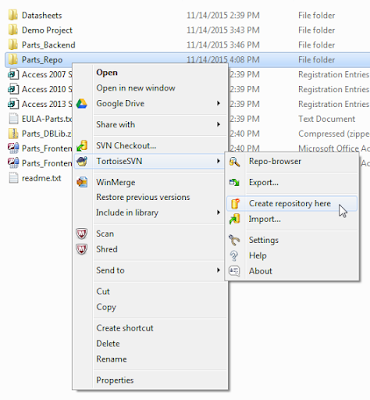
That's It !
Name the repository folder to something that works for you.
Example: To create the repository "Parts_Repo" folder.
Using Windows file explorer select the "Parts_Repo" folder.
Then Right Click > TortoiseSVN > Create repository here.

Close Tortoise
Using Windows file explorer > Right click on the repo folder and select TortoiseSVN > Repo-browser.
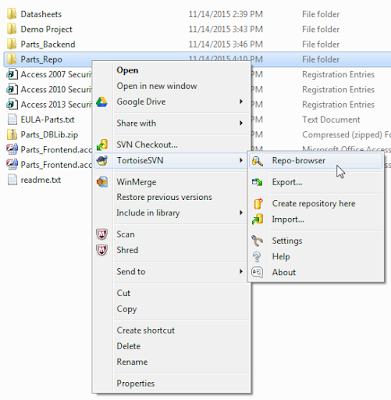
Using Windows file explorer > Right click on the repo folder and select TortoiseSVN > Repo-browser.

Optional Folders may be created if desired, i.e.
Datasheets
CAD Models
Copy the path to the repository i.e. "file:///C:/Parts_DBLib/Parts_Repo"
Import *.PCBLIB and *.SCHLIB files in to the new repository.
Example: Using the Parts DBLIB demo *.PCBLIB files.
Browse to the folder on your local drive where you installed the Parts Demo > Select the Footprints folder > Right click > TortoiseSVN > Import
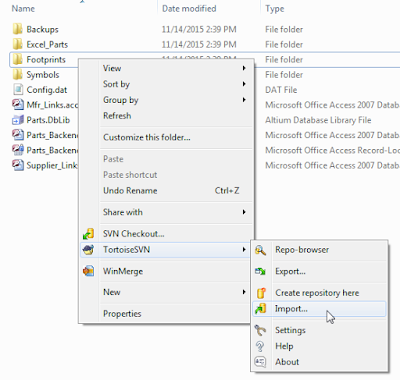
Import *.PCBLIB and *.SCHLIB files in to the new repository.
Example: Using the Parts DBLIB demo *.PCBLIB files.
Browse to the folder on your local drive where you installed the Parts Demo > Select the Footprints folder > Right click > TortoiseSVN > Import

Enter the Parts_Repo path or use the browse to button [...] to select the Footprints folder in the repo > then select Ok.
The footprint files should be imported into the New Repo/Footprints folder.
Repeat for the Symbols folder.
Repeat for the Symbols folder.
Repeat for the Datasheets folder. (optional folder)
Repeat for the CAD Models folder. (optional folder)
That's It !
Friday, July 24, 2015
Configure and Distribute Parts
Configure the Parts application
The Parts librarian can easily configure and distribute the Parts Frontend.
Use the Frontend application to create and save the configured application.
Then Zip up and distribute the configured Parts_Frontend to your users.
Zip up the Parts_Frontend file and place the Zipped file in a shared network drive folder.
Instruct users to copy the zip file and extract the Part_Frontend file in a folder on their local C:\ drive.
Notes:
If users have Access 2010 or higher installed on their machine they can run the Parts_Frontend.accde.
If the users do NOT have Access 2010 or higher on their computer they can install the free Microsoft Access runtime and run the Parts Frontend.
Steps for Upgrading to the latest version of the Part Frontend:
Save a copy of your existing Parts Frontend in the event you want to roll back to the older version.
Download and Drop the latest Parts_Frontend in the same folder where your previous version of the Frontend was installed.
Place the Zipped and Configured Parts_Frontend file in a shared network drive folder.
To keep the users on the same version of the Parts Frontend, instruct users to copy and extract the zipped Parts_Frontend file to a folder on their local C:\ drive.
Related Link: Moving and Sharing Parts
That's it !
The Parts librarian can easily configure and distribute the Parts Frontend.
Use the Frontend application to create and save the configured application.
Then Zip up and distribute the configured Parts_Frontend to your users.
Zip up the Parts_Frontend file and place the Zipped file in a shared network drive folder.
Instruct users to copy the zip file and extract the Part_Frontend file in a folder on their local C:\ drive.
Notes:
If users have Access 2010 or higher installed on their machine they can run the Parts_Frontend.accde.
If the users do NOT have Access 2010 or higher on their computer they can install the free Microsoft Access runtime and run the Parts Frontend.
Steps for Upgrading to the latest version of the Part Frontend:
Save a copy of your existing Parts Frontend in the event you want to roll back to the older version.
Download and Drop the latest Parts_Frontend in the same folder where your previous version of the Frontend was installed.
Place the Zipped and Configured Parts_Frontend file in a shared network drive folder.
To keep the users on the same version of the Parts Frontend, instruct users to copy and extract the zipped Parts_Frontend file to a folder on their local C:\ drive.
Related Link: Moving and Sharing Parts
That's it !
Sunday, June 28, 2015
Export to Excel
To Export the Entire Parts Database > Select Tools > Export
To Export Filtered Records > Select Filter > Export.
Choose Options (Optional - Not Required) > Then Export
Checking Acquire Models will copy Symbol and Footprint files.
The Acquired Models folder will be created in the same folder as the Exported data.
Tip:
To Prevent overwriting the ID Field (Primary Key) you may want to delete the ID column in the exported Excel workbook if you are planning to merge or append the exported data with another Parts compatible database.
That's it !
Saturday, June 13, 2015
Import Excel
Excel data can be imported restore the database or update existing records in the database.
For speed Parts creates and uses a locally cloned table for Linked MySQL databases.
Bill of Materials can be imported,
The Import command can used to append and update the Destination table from the imported data. The Import command also includes a few options.
Select Import to append and update records.
Import Options:
Import Options are applied to the Imported table.
Note that Import Options are automatically unchecked when Import Excel form is opened, this is by design to prevent any unexpected surprises.
Build Part Descriptions
This option will build a Part Descriptions for Capacitors, Resistors and Inductors if the Part Description is blank (empty) in the imported datasheet.
Example:
CAP CER 0.1uF ±10% 10V X5R 0402 (1005 Metric)
The above description was built by concatenating fields (parameters):
Part Type, SubType, Value, Tolerance, Voltage Dielectric and Package Case
Use Preferred Names
This option can be used to create consistent Supplier and Mfr Names.
Make Library Paths
This option can be used to create Library Paths by prefixing Library Refs with Footprints\ or Symbols\ when a BOM is imported and the Library Ref parameter is included. Parts will attempt to build the Library Path if this option is enabled. Paths are only created for records that have no Library Path and if Library files exist in the Footprints or Symbols folders.
Tip:
The Import command can used to append and update the Destination table from the imported data. The Import command also includes a few options.
The Compare command can be used to selectively append or update records in the Destination table with data from the imported Excel source data.
click on image to view
click on image to view
Map parameters in the Source and Destination tables.
Select Import to append and update records.
Import Options:
Import Options are applied to the Imported table.
Note that Import Options are automatically unchecked when Import Excel form is opened, this is by design to prevent any unexpected surprises.
Build Part Descriptions
This option will build a Part Descriptions for Capacitors, Resistors and Inductors if the Part Description is blank (empty) in the imported datasheet.
Example:
CAP CER 0.1uF ±10% 10V X5R 0402 (1005 Metric)
The above description was built by concatenating fields (parameters):
Part Type, SubType, Value, Tolerance, Voltage Dielectric and Package Case
Use Preferred Names
This option can be used to create consistent Supplier and Mfr Names.
Make Library Paths
This option can be used to create Library Paths by prefixing Library Refs with Footprints\ or Symbols\ when a BOM is imported and the Library Ref parameter is included. Parts will attempt to build the Library Path if this option is enabled. Paths are only created for records that have no Library Path and if Library files exist in the Footprints or Symbols folders.
Tip:
Use Altium's Library Splitter Wizard to push library files to the Footprints and Symbols folders.
Update Time Stamps
This option can be used to modify the Updated_By and Updated_Date fields.
Notes:
When the Destination is the 'Parts' table and the ID column is not included in the Imported data the ID is automatically generated using next higher available ID numbers.
Update Time Stamps
This option can be used to modify the Updated_By and Updated_Date fields.
Notes:
When the Destination is the 'Parts' table and the ID column is not included in the Imported data the ID is automatically generated using next higher available ID numbers.
The Imported ID field must not contain a combination of blanks and ID values.
Required fields are determined by properties that are set in the Backend database.
New part numbers are appended and all records with matching IDs are updated.
Tips:
The Import command updates all records where the IDs in the Source data match the IDs in the Destination table. Records in the source data are appended to the destination table where the IDs are not matched (new records).
Note that data in the Destination table will be overwritten with data from the Source table where the IDs are matched.
Use Compare if you want to review the changes and updates prior to importing the data.
That's It !
Required fields are determined by properties that are set in the Backend database.
New part numbers are appended and all records with matching IDs are updated.
Tips:
The Import command updates all records where the IDs in the Source data match the IDs in the Destination table. Records in the source data are appended to the destination table where the IDs are not matched (new records).
Note that data in the Destination table will be overwritten with data from the Source table where the IDs are matched.
Use Compare if you want to review the changes and updates prior to importing the data.
That's It !
Sunday, May 24, 2015
Required Fields
Required fields (user inputs) are determined by settings in the Backend database.
Please read before modifying fields in the Parts Backend. Parts fields can be changed, however Parts has been optimized for ease of use and performance.
Example: To set RoHS as a user required input.
Open the Backend Parts table in the Design View.
Set the 'Required' property for RoHS to 'Yes" as shown below.

Tip 1: If you do NOT use Required fields in the Backend Parts table, you will have fewer nagging popup messages when you save records or scroll the records.
Tip 2: If you create Required Fields include a Default Value to avoid nagging messages.
Example: Required RoHS Field with Default Value set to "UnKnown"
Tip 3: For a nag free experience, set all fields Required property to No.
Tip 4: Importing Excel files will be simple if you do not use required fields.
Records can NOT be imported if the Excel data does not include the required fields.
Tip 5: To determine if you have required fields in the Backend Parts table.
Open the Parts table in the backend database in the design view.
Select a field and review the Required property setting for the field.
That's It !
Please read before modifying fields in the Parts Backend. Parts fields can be changed, however Parts has been optimized for ease of use and performance.
Example: To set RoHS as a user required input.
Open the Backend Parts table in the Design View.
Set the 'Required' property for RoHS to 'Yes" as shown below.

Tip 1: If you do NOT use Required fields in the Backend Parts table, you will have fewer nagging popup messages when you save records or scroll the records.
Tip 2: If you create Required Fields include a Default Value to avoid nagging messages.
Example: Required RoHS Field with Default Value set to "UnKnown"
Tip 3: For a nag free experience, set all fields Required property to No.
Tip 4: Importing Excel files will be simple if you do not use required fields.
Records can NOT be imported if the Excel data does not include the required fields.
Tip 5: To determine if you have required fields in the Backend Parts table.
Open the Parts table in the backend database in the design view.
Select a field and review the Required property setting for the field.
That's It !
Saturday, May 23, 2015
Use Company Part Numbers
By default Parts uses a unique incremented 'ID' to link the database to an Altium design.
Example DBLib or SVNDBLIB with Single lookup key set to use the ID field.

Using a unique key (ID) allows database parts to be linked to a design without the need to create company part numbers.
Company part numbers can easily be added before or after the design is released when a unique key (ID) is used as the lookup field.
For greater flexibility I highly recommend using the unique ID as the lookup key.
Suggested reading: PLM
In Parts MCN = Material Control Number (company part number)
That's It !
Example DBLib or SVNDBLIB with Single lookup key set to use the ID field.

Using a unique key (ID) allows database parts to be linked to a design without the need to create company part numbers.
Company part numbers can easily be added before or after the design is released when a unique key (ID) is used as the lookup field.
For greater flexibility I highly recommend using the unique ID as the lookup key.
Suggested reading: PLM
In Parts MCN = Material Control Number (company part number)
That's It !
Saturday, April 11, 2015
Warning - File Locking
Problem: Altium Warning - You will not be able to save your changes
Fix: Disable the File Locking Option in DXP Preferences
Tools > DXP > Preferences File Locking
click on image to view
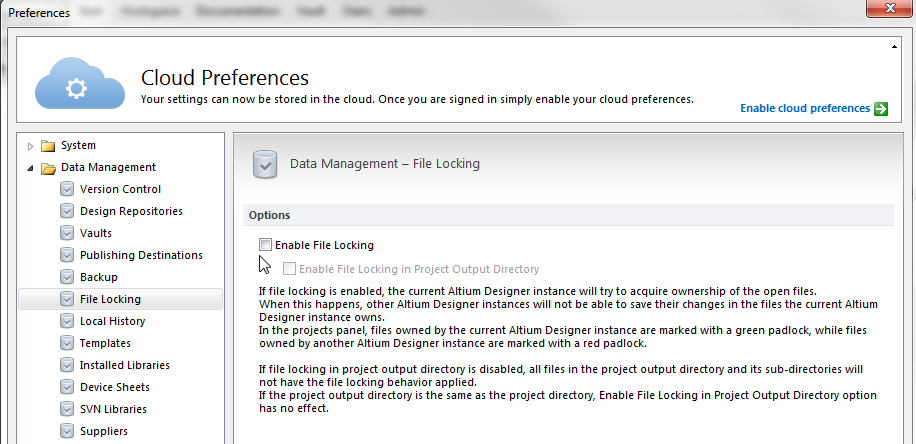
That's It !

Fix: Disable the File Locking Option in DXP Preferences
Tools > DXP > Preferences File Locking
click on image to view

That's It !
Friday, April 10, 2015
EOleException error executing
Provider cannot be found . . .
EOleException error raised in Altium DBLIB or SVNDBLIB when connecting to an Access Database.
Provider cannot be found. It may not be properly installed.
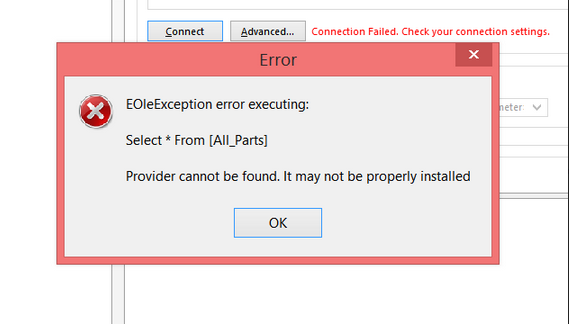
For AD17 and older 32bit versions of Altium DXP.
To fix this connection error install a 32 bit AccessDatabaseEngine.exe
Download 2010 AccessDatabaseEngine.exe
or
Download 2016 Access DatabaseEngine.exe
Read:
The 'Microsoft.ACE.OLEDB.12.0' provider is not registered on the local machine - ConnectionStrings.com
That's It !
EOleException error raised in Altium DBLIB or SVNDBLIB when connecting to an Access Database.
Provider cannot be found. It may not be properly installed.

For AD17 and older 32bit versions of Altium DXP.
To fix this connection error install a 32 bit AccessDatabaseEngine.exe
Download 2010 AccessDatabaseEngine.exe
or
Download 2016 Access DatabaseEngine.exe
Read:
The 'Microsoft.ACE.OLEDB.12.0' provider is not registered on the local machine - ConnectionStrings.com
That's It !
Tuesday, March 31, 2015
User Defined Fields
The Parts Frontend supports up to 15 user defined text fields.
YouTube Video User Defined Fields
Close all connections to the Database (Parts Backend) !
A database should not be re-designed while users are connected to the database.
If users are connected to Parts Database ask them to close their Parts Frontend applications and Altium connections while you modify the Parts Database.
For MySQL use MySQL Workbench to add fields to the Backend Database. Then in the Parts Frontend Select Configuration > User Defined Fields, enter the user defined fields and select Apply in the Configuration form.
Example to add a field Named Package_Size to the Parts database.
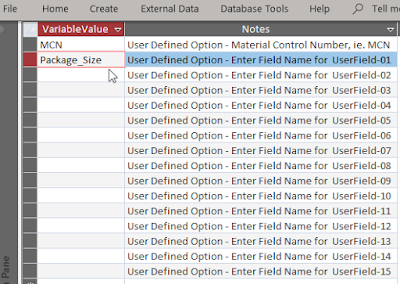
Close the form and select the Apply button in the Configuration dialog to create the fields.
Unbound fields are fields that are not linked to the main form.
To remove unbound fields use Tools > Clean Parts > Delete Unbound Fields. Or edit the Parts Backend database.
Notes:
Configurations can be saved to and loaded from a local or shared network drive.
Do NOT delete the User-defined records. Leave the VariableValue column blank or enter a field name to add a new field.
Each user has a User.ini file (user preferences) which is stored in the same folder as the Parts Frontend on the user's machine.
Close all connections to the Database (Parts Backend) !
A database should not be re-designed while users are connected to the database.
If users are connected to Parts Database ask them to close their Parts Frontend applications and Altium connections while you modify the Parts Database.
For MySQL use MySQL Workbench to add fields to the Backend Database. Then in the Parts Frontend Select Configuration > User Defined Fields, enter the user defined fields and select Apply in the Configuration form.
For MySQL User Defined Fields can be added using the Pats Frontend if the user named in the connection string has been given privileges and permissions to alter the MySQL database.
If the named user does NOT have permissions and privileges an ADO Error Handler message will pop up if the user attempts to alter (add fields) to the database.
For Access databases you can Select Configuration > User Defined Fields, enter the user defined fields and select Apply in the Configuration form.
Example to add a field Named Package_Size to the Parts database.

Close the form and select the Apply button in the Configuration dialog to create the fields.
Unbound fields are fields that are not linked to the main form.
To remove unbound fields use Tools > Clean Parts > Delete Unbound Fields. Or edit the Parts Backend database.
Notes:
Configurations can be saved to and loaded from a local or shared network drive.
Do NOT delete the User-defined records. Leave the VariableValue column blank or enter a field name to add a new field.
Each user has a User.ini file (user preferences) which is stored in the same folder as the Parts Frontend on the user's machine.
Part Status in legacy versions used . . .
New;Checked;Released;Production;Deprecated;End of Life;Obsolete;
The latest version of Parts uses Dynamic user defined Part Status.
Dynamic values are created by simply entering test in the Part Status field.
Monday, February 23, 2015
Linking Parts
Parts uses a Surrogate Key field (ID) to link the parts placed in an Altium design.
The ID filed is a simple incremented long integer which creates a flexible solution.
The ID field is a unique identifier.
The ID field is the Primary key in the Parts Backend table.
No Duplicates are allowed in the ID field.
By design user's do not need to create company part numbers before parts can be placed.
Creating company part numbers can be an exercise in futility. New designs often have parts that are evaluated and never used in the final design.
Parts also has a Lifecycle field that includes "Obsolete" and "Deprecated", which allows for identifying these parts in the CAD Library and on the BOM.
Company Part Numbers
Parts has an optional Material Control Number (MCN) field for company part numbers.
MCNs (company part numbers) are created in PLM systems to associate preferred and alternate manufacturer parts for production BOMs.
Typically company part numbers are assigned after a design has been released from engineering to production.
CAD libraries and schematics can be updated with MCNs using the unique ID field.
Parts has options for customizing the MCN field.
Related Link: PLM
The ID filed is a simple incremented long integer which creates a flexible solution.
The ID field is a unique identifier.
The ID field is the Primary key in the Parts Backend table.
No Duplicates are allowed in the ID field.
By design user's do not need to create company part numbers before parts can be placed.
Creating company part numbers can be an exercise in futility. New designs often have parts that are evaluated and never used in the final design.
Parts also has a Lifecycle field that includes "Obsolete" and "Deprecated", which allows for identifying these parts in the CAD Library and on the BOM.
Company Part Numbers
Parts has an optional Material Control Number (MCN) field for company part numbers.
MCNs (company part numbers) are created in PLM systems to associate preferred and alternate manufacturer parts for production BOMs.
Typically company part numbers are assigned after a design has been released from engineering to production.
CAD libraries and schematics can be updated with MCNs using the unique ID field.
Parts has options for customizing the MCN field.
Related Link: PLM
That's It !
Tuesday, January 27, 2015
Compare
Compare is a Librarian only feature in the Parts Frontend application.
Compare can also be used to append and update records from an Imported Excel file.
Compare can also be used to append and update records from an Imported Excel file.
Click on image to view
How Compare works:
Compare stops at the first difference found and displays records with differences.
If differences are found the command buttons can be used to update the Destination table.
To find more differences the user must first reconcile the displayed differences.
If you would like to review the differences without changing any data in the Parts table you can Swap Tables and select Compare.
If you update the Imported table no changes are made to the Imported Excel file. The changes are only made to a temporary Imported table.
That's It !
How Compare works:
Compare stops at the first difference found and displays records with differences.
If differences are found the command buttons can be used to update the Destination table.
To find more differences the user must first reconcile the displayed differences.
If you would like to review the differences without changing any data in the Parts table you can Swap Tables and select Compare.
If you update the Imported table no changes are made to the Imported Excel file. The changes are only made to a temporary Imported table.
That's It !
Monday, January 19, 2015
BOM - With Supplier Links Enabled
I'm currently working on a fairly large project with 20 schematic pages, 225 line items, 1034 parts (Ref/Des).
Generating the Bill of Material is taking several minutes.
After a little troubleshooting I found that if I disabled the Suppliers in DXP Preferrences the BOM would generate in a few seconds, vice several minutes.
As shown below enabling the Suppliers Links will display real time Supplier Information in the Libraries Panel.
This is a nice feature when you are placing parts, but it comes at price when you want to configure or generate your BOM..
The reason for the performance hit is Altium searches the supplier websites looking for inventory and pricing for the 225 line items in the BOM, this takes a considerable amount of time.
If are using an Outjob to generate your BOM and you select Configure the configuration dialog will also take a few minutes to open if the Supplier Links are enabled.
Altium Bug Crunch #1508
Altium will freeze, but eventually thaw out and come back to life.
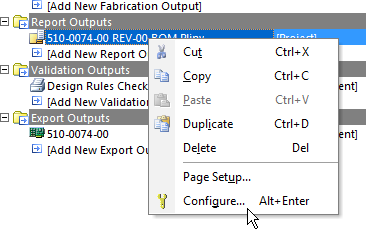
Work around 1:
To speed up the BOM un-check the Supplier Links in DXP Preferences before generating or configuring a BOM in the Outjob.
Interesting point:
In my Outjob BOM Configuration I have not selected stock or pricing information.
Supplier 1 and Supplier Part Number 1 are already in my design's database.
Why is Altium searching the Internet for Supplier Data?
Work Around 2:
Open the Parts Backend and rename Supplier 1 to Supplier and Supplier Part Number 1 to Supplier Part Number.
This will stop the long searches for supplier data on the web. However the Supplier details will not be visible in the Libraries panel.
You can quickly open Supplier Part Details or datasheets using right clicks in the library panel or schematic.
Related link: Supplier Data
That's It !
Generating the Bill of Material is taking several minutes.
After a little troubleshooting I found that if I disabled the Suppliers in DXP Preferrences the BOM would generate in a few seconds, vice several minutes.
As shown below enabling the Suppliers Links will display real time Supplier Information in the Libraries Panel.
This is a nice feature when you are placing parts, but it comes at price when you want to configure or generate your BOM..
The reason for the performance hit is Altium searches the supplier websites looking for inventory and pricing for the 225 line items in the BOM, this takes a considerable amount of time.
If are using an Outjob to generate your BOM and you select Configure the configuration dialog will also take a few minutes to open if the Supplier Links are enabled.
Altium Bug Crunch #1508
Altium will freeze, but eventually thaw out and come back to life.

Work around 1:
To speed up the BOM un-check the Supplier Links in DXP Preferences before generating or configuring a BOM in the Outjob.
Interesting point:
In my Outjob BOM Configuration I have not selected stock or pricing information.
Supplier 1 and Supplier Part Number 1 are already in my design's database.
Why is Altium searching the Internet for Supplier Data?
Work Around 2:
Open the Parts Backend and rename Supplier 1 to Supplier and Supplier Part Number 1 to Supplier Part Number.
This will stop the long searches for supplier data on the web. However the Supplier details will not be visible in the Libraries panel.
You can quickly open Supplier Part Details or datasheets using right clicks in the library panel or schematic.
Related link: Supplier Data
That's It !
Subscribe to:
Posts (Atom)























